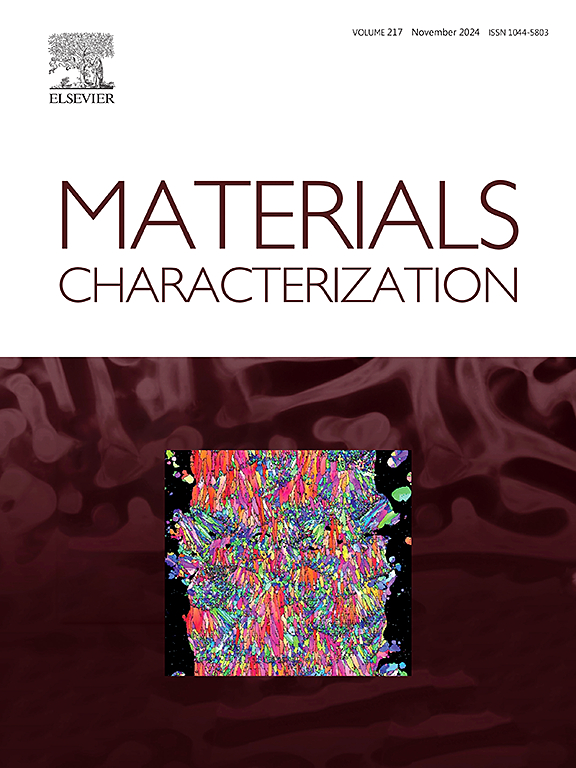TiO2 addition induced grain refinement and hardening of laser-clad FeCrAl coating on T91 steel
IF 4.8
2区 材料科学
Q1 MATERIALS SCIENCE, CHARACTERIZATION & TESTING
引用次数: 0
Abstract
To overcome the shortcoming of FeCrAl coatings liable to form coarse columnar grains, this work explores the influence of TiO₂ addition on grain structure and hardness characteristics of laser-clad FeCrAl coatings on T91 steel. Results show that the cross-sections of the FeCrAl and FeCrAl/TiO2 coating samples consist of three regions: cladding zone (CZ), heat-affected zone (HAZ) and substrate, with distinct microstructural features. The CZ of the FeCrAl coating sample is composed of coarse columnar grains (average size 35.5 ± 0.7 μm), while the FeCrAl/TiO2 coating consists of uniform equiaxed grains with an much smaller average size of 7.8 ± 0.4 μm. Analysis indicates that the TiO2 particles added into the initial powders undergo decomposition during laser heating and re-precipitate as Ti-rich nano-particles during subsequent cooling, which can act as heterogeneous nucleation sites and promote the formation of equiaxed grains. The HAZs of both the laser-clad samples are composed of fine martensitic laths, with specific orientation relationships followed during the martensitic transformation, resulting in distinct misorientation characteristics. Hardness tests show that the FeCrAl and FeCrAl/TiO2 coatings have average hardnesses of 264.1 ± 3.6 HV and 327.6 ± 10.4 HV, respectively, both much greater than the substrate (206.4 ± 2.9 HV). Quantitative analysis of microstructural characteristics indicates that the greater hardness of the FeCrAl/TiO2 coating can be ascribed to combined grain-refinement strengthening, second-phase strengthening and solid-solution strengthening.
TiO2的加入诱导了T91钢激光熔覆层的晶粒细化和硬化
为了克服feral涂层容易形成粗柱状晶粒的缺点,研究了tio2添加对T91钢激光熔覆feral涂层晶粒组织和硬度特性的影响。结果表明:FeCrAl和FeCrAl/TiO2涂层样品的横截面由熔覆区(CZ)、热影响区(HAZ)和基体三个区域组成,具有明显的显微组织特征;FeCrAl涂层样品的CZ由粗柱状晶粒组成(平均尺寸为35.5±0.7 μm),而FeCrAl/TiO2涂层由均匀等轴晶粒组成,平均尺寸为7.8±0.4 μm。分析表明,加入到初始粉末中的TiO2颗粒在激光加热过程中分解,在后续冷却过程中再析出富ti纳米颗粒,作为非均相成核位点,促进等轴晶的形成。两种激光熔覆试样的haz均由细小的马氏体板条组成,在马氏体相变过程中遵循特定的取向关系,形成明显的错取向特征。硬度测试表明,镀层的平均硬度分别为264.1±3.6 HV和327.6±10.4 HV,均远高于基体(206.4±2.9 HV)。显微组织特征的定量分析表明,FeCrAl/TiO2涂层硬度的提高可归因于晶粒细化强化、第二相强化和固溶强化的结合。
本文章由计算机程序翻译,如有差异,请以英文原文为准。
求助全文
约1分钟内获得全文
求助全文
来源期刊

Materials Characterization
工程技术-材料科学:表征与测试
CiteScore
7.60
自引率
8.50%
发文量
746
审稿时长
36 days
期刊介绍:
Materials Characterization features original articles and state-of-the-art reviews on theoretical and practical aspects of the structure and behaviour of materials.
The Journal focuses on all characterization techniques, including all forms of microscopy (light, electron, acoustic, etc.,) and analysis (especially microanalysis and surface analytical techniques). Developments in both this wide range of techniques and their application to the quantification of the microstructure of materials are essential facets of the Journal.
The Journal provides the Materials Scientist/Engineer with up-to-date information on many types of materials with an underlying theme of explaining the behavior of materials using novel approaches. Materials covered by the journal include:
Metals & Alloys
Ceramics
Nanomaterials
Biomedical materials
Optical materials
Composites
Natural Materials.
 求助内容:
求助内容: 应助结果提醒方式:
应助结果提醒方式:


